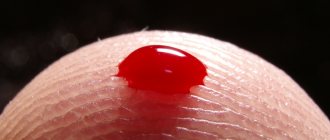Pediatrician
Sayfulina
Maryam Zakareevna
31 years of experience
Pediatrician of the highest category, member of the Union of Pediatricians of Russia
Make an appointment
Hemophilia is a hereditary pathology of homeostasis, manifested in a violation of blood clotting against the background of reduced synthesis of necessary substances by the patient’s body (factors VII, IX, XI). Persons suffering from the disease regularly find hematomas on their bodies or encounter hemarthrosis, internal bleeding due to injuries or surgical interventions. Treatment of hemophilia in children is based on replacement therapy, which must be received throughout life.
Reasons for the development of pathology
The mechanism and type of inheritance of hemophilia have been studied in sufficient detail. Genes that provoke insufficient production of blood clotting factors are linked to the X chromosome. The pathology is inherited recessively through the female line. Hereditary pathology occurs exclusively in boys.
The sons of a healthy man and a woman who is a carrier of the pathological gene are equally likely to be born without signs of hemophilia or with them. A man suffering from bleeding disorders will be able to conceive healthy children with a woman who is not a carrier of the altered gene.
Medicine knows of isolated cases of hemophilia in women. Their mothers were carriers of a mutated gene, and their fathers suffered from insufficient production of blood clotting factors. The cause of hemophilia in such cases is a combination of recessive and dominant genes.
Diagnosis inherited
Hemophilia is an inherited disease. The hemophilia genes are located on the sex X chromosome, which is passed from grandfather to grandson through a healthy daughter who is a carrier of the defective gene. That is, men usually suffer from the disease, while women act as carriers of hemophilia and can give birth to sick sons or carrier daughters. According to WHO statistics, approximately one male infant in 5,000 is born with hemophilia A, regardless of nationality or race.
Article on the topic
Blood in facts and figures
However, hemophilia can appear even if the child in the family did not have carriers of the disease genes.
The most famous carrier of hemophilia in history was Queen Victoria of England. There is a version that the mutation occurred precisely in the genotype, since there were no people suffering from hemophilia in the families of her parents. According to another version, the presence of the hemophilia gene in Queen Victoria can be explained by the fact that her father was not Edward Augustus, Duke of Kent, but another man with hemophilia. But there is no historical evidence in favor of this version.
Live. Why did doctors give Queen Victoria chloroform? Read the article>>
The Queen of England passed on this disease as an “inheritance” to the reigning families of Germany, Spain and Russia. One of Victoria's sons and a number of grandchildren and great-grandchildren suffered from hemophilia, including the Russian Tsarevich Alexei Nikolaevich . That is why the disease received its informal names - “Victorian disease” and “Royal disease”.
The last prince. The son of Nicholas II paid for the sins of others
More details
Classification of the disease
Types of hemophilia are distinguished based on the deficiency of a certain blood clotting factor in the patient's body. Basic information about the types of disease is presented in the table.
| View | Description |
| A | It is diagnosed in 84-86% of people suffering from the pathology in question. Caused by a deficiency of clotting factor VIII (antihemophilic globulin). |
| B | Occupies a share of 12-13% of clinically diagnosed cases of hemophilia. Develops against the background of deficiency of coagulation factor IX (thromboplastin) |
| C | Occurs no more often than 1-2%. Becomes a consequence of insufficient production of blood coagulation factor XI. |
About 0.5% of detected cases of hemophilia of various etiologies belong to other types - V, VII, X and others.
Pathogenesis
The pathogenesis of hemophilia is based on a deficiency of plasma factors (VIII, IX, XI) of blood coagulation, which causes a disruption of the process of blood coagulation in the internal coagulation unit of hemostasis (formation of thromboplastin) and causes hematoma delayed type of bleeding. The first stage of blood coagulation is the process of thromboplastin formation, which occurs normally only if there is a sufficient concentration of factors VIII and IX. Its duration is 12-15 minutes, and the subsequent process of blood clotting after the appearance of active thromboplastin in the blood occurs almost instantly.
It is the disruption of this plasma phase of hemostasis that causes the type of bleeding characteristic of hemophilia. Bleeding immediately after injury may be absent, since primary (vascular-platelet) hemostasis functions normally, which ensures the formation of a primary thrombus.
Since the primary thrombus is not able to provide a final stop of bleeding, secondary hemostasis suffers - the formation of a fibrin (final) thrombus, the bleeding resumes and occurs suddenly a few hours (the next day) after surgery/trauma. At the same time, despite its duration, there is no increase in the volume of blood loss, which is its feature. The figure below schematically shows the pathogenesis of hemophilia.
Symptoms of hemophilia
The first signs of pathology can be detected in newborns. Thus, the likelihood of confirming the diagnosis of hemophilia in a child will be indicated by prolonged bleeding from the umbilical cord and numerous subcutaneous hematomas. Excessive bleeding in infants at the time of teething becomes no less alarming. But during lactation, the child receives a sufficient amount of thrombokinase with mother's milk.
Post-traumatic bleeding is typical for children who have learned to crawl and walk. In addition to nosebleeds, intermuscular hematomas and hemorrhages in the joints (hemarthrosis) are added. Against this background, anemia develops.
As children age, they may experience bleeding from the gastrointestinal tract. This is caused by injury or medical procedures. The greatest danger is bleeding from the nasopharynx and pharynx. Against this background, airway obstruction may develop.
Are you experiencing symptoms of hemophilia?
Only a doctor can accurately diagnose the disease. Don't delay your consultation - call
Myths and facts
The patient can die from a small scratch . This is not so, the danger comes from major injuries and surgical operations, tooth extraction, spontaneous internal hemorrhages in muscles and joints.
Only men are affected by hemophilia . This is not entirely true. Women also suffer from hemophilia, but extremely rarely. About 60 cases of hemophilia in girls have been described worldwide. According to one version, the rarity of this disease among women is due to the physiology of the female body: monthly blood loss due to poor blood clotting leads to early death.
Patients with hemophilia cannot undergo surgery . That’s right, any surgical interventions are permitted only for health reasons and if it is possible to organize replacement therapy with blood clotting factor drugs. In addition, patients with hemophilia cannot engage in physical activity and sports, and it is also dangerous for them to administer drugs intramuscularly.
A woman with hemophilia genes will definitely give birth to a sick child . In fact, this is not entirely true, because carriers of the hemophilia gene cannot plan the birth of a sick or healthy child. The only exception can be the procedure of in vitro fertilization (IVF), but subject to a number of conditions. Diagnose the presence of hemophilia in the fetus from the 8th week of pregnancy.
Diagnosis of pathology
Diagnostic procedures are performed by doctors of several specializations: neonatologist, pediatrician, geneticist and hematologist. For concomitant pathologies, consultation with a gastroenterologist, orthopedist, otolaryngologist and neurologist may be required.
At-risk couples should visit a doctor before conceiving a child. Molecular genetic research of biomaterials from future parents will allow us to take into account the risk of having a child with hemophilia. After conception, prenatal screenings may be performed. Their results will confirm or refute the fact that the child inherited hemophilia.
Neonatal tests performed in the first days of a baby’s life are no less effective. A coagulogram provides the neonatologist with comprehensive information about the production of coagulation factors by the newborn’s body.
In case of hemarthrosis, the child is prescribed an X-ray examination of the joints. Ultrasound diagnostics is performed when signs of internal bleeding and retroperitoneal hematomas are detected.
List of sources
- Protocol for the management of patients with Hemophilia. Problems of standardization in healthcare 2006, p. 18-74.
- Guide to hematology: in 3 volumes. T.3 / Edited by A.I. Vorobyov. 3rd ed. M., 2005.
- Rumyantsev A.G., Rumyantsev S.A., Chernov V.M. Hemophilia in the practice of doctors of various specialties. 2013. 136 p.
- Tretyakova O.S. Hemophilia in children: etiopathogenesis, clinical manifestations, diagnostic approaches //Children's medicine. 2012, 3-4 (16-17) p. 26-35.
- Zozulya N.I., Kumskova M.A., Polyanskaya T.Yu., Svirin P.V. // Clinical guidelines for the diagnosis and treatment of hemophilia. 2021. 34 p.
Treatment of the disease
Therapeutic measures during the treatment of hemophilia belong to one of two groups - preventive or symptomatic. In the first case, a patient with a severe form of pathology receives regular doses of blood clotting factor concentrates. Their presence reduces the risk of developing arthropathy and internal bleeding. When planning surgical interventions (including tooth extraction), the patient receives repeated drug transfusions.
Symptomatic procedures are performed for cuts and external bleeding. Doctors recommend using a hemostatic sponge and applying a pressure bandage. Small wounds should be treated with thrombin.
4.What can be done at home for hemophilia?
To prevent bleeding and improve your well-being, patients with hemophilia can recommend the following:
- Ask your doctor about how to manage bleeding if you have hemophilia;
- Maintain a healthy weight. Additional stress on joints due to excess weight can cause bleeding in hemophilia;
- Choose forms of physical activity with caution. It is better to give preference to swimming and other sports that do not put unnecessary stress on the joints;
- Consult your doctor before taking any medications. And do not take aspirin, ibuprofen or other non-steroidal anti-inflammatory drugs because they affect blood clotting.
- Organize your living space to avoid injuries and accidents as much as possible.
Forecast
Replacement therapy allows the patient's body to produce a sufficient amount of antibodies that block procoagulant activity. Additional measures to support boys or men include plasmapheresis and the use of immunosuppressants. Against the background of regular blood and plasma transfusions, patients may encounter HIV, hepatitis, herpes or cytomegalovirus.
Mild hemophilia does not have a significant impact on the quality and life expectancy of patients. In severe forms of the pathology, the survival prognosis is significantly worse. Clinical guidelines for hemophilia include regular consultation of patients with a hematologist and monitoring of blood clotting parameters through laboratory tests.
Hemophilia: what kind of disease is it, what do you need to know about it?
HEMOPHILIA: what kind of disease is it?
what do you need to know about it?
The unusual frequency with which this disease occurs among different generations of the same family has long led to the suspicion that hemophilia is a hereditary blood disease. It has been established that women, without being sick themselves, transfer hemophilia from one family to another. A typical example of female bloodborne disease in European history is the family tree of Queen Victoria of England, from whom the disease spread to many other royal houses. The son of the last Russian Tsar suffered from this disease.
However, hemophilia does not only affect aristocratic dynasties. It can occur in any child who has a family member who suffered from this blood disease.
Hemophilia is a congenital hereditary disease. Of course, it is the most famous among genetically determined blood diseases.
Hemophilia is expressed in increased bleeding, be it as a result of external, even the smallest injuries, or internal bleeding in tissues, joint capsules, etc. An injury that causes almost unstoppable bleeding can be extremely minor.
This blood disease has serious consequences for internal organs and joints, causing concomitant diseases and abnormalities.
Causes of hemophilia
Scientists attribute hereditary factors to the main reasons provoking the development of hemophilia disease. Genetically defective blood clotting is inherited from generation to generation, and the carrier of the defective gene is exclusively the female body, and the patient with hemophilia, as a rule, is a man. In fairness, it is worth noting that there are scientifically described cases of hemophilia in women, but these cases are extremely rare and occur when both parents of a sick girl are carriers of the damaged gene. By passing the disease on to her children, the woman “conductor” herself remains healthy, her sons are doomed to hemophilia, and her daughters also become carriers of the hidden gene until they pass it on to their children. Therefore, the only way to interrupt the pathological chain is to take advantage of the rather cruel advice of geneticists and carefully plan the birth of future offspring. In accordance with the recommendations of modern geneticists, carrier women should not have children at all, and only sons should be born in families of hemophiliac men and healthy women; women who are pregnant with girls are offered to undergo an artificial abortion procedure. Currently, scientists have not yet found a way to eliminate the cause of hemophilia; today, unfortunately, this is not yet possible, because it is embedded in the human genetic code. A patient with hemophilia has nothing left to do except learn to live with this disease and get used to the fact that his body every day needs special precautions and especially careful treatment.
Disorders caused by hemophilia
Blood coagulation is a complex biochemical process in which fibrinogen, a protein contained in plasma, changes its structure. This occurs under the influence of various factors, among which the release of tissue thromboplastin is very important. The formation of thromboplastin occurs with the help of numerous substances that are found in small quantities in the blood. One of them, factor VIII, or antihemophilic factor (AHF), is absent or insufficiently present in those affected by hemophilia. The term hemophilia actually refers to two diseases that have the same symptoms but different causes.
There are two types of hemophilia, namely:
Hemophilia A, or classical hemophilia
Hemophilia B, or Christmas disease
Hemophilia C is an extremely rare type that mainly affects Jews
The second type is less common. Type A lacks factor VIII; in hemophilia B, it is factor IX, or plasma, thromboplastin, called Christmas factor. It is also important for blood clotting, and it becomes almost impossible in its absence.
The third type occurs due to a deficiency of factor XI. Due to the non-standard clinical picture, not so long ago this type was isolated separately and is not included in the types of hemophilia.
What is acquired hemophilia?
Hemophilia is inherited. However, cases have been recorded when manifestations of this disease were observed in adults who had not been sick before and did not have patients in their family. Acquired hemophilia is always type A. In half of the cases, doctors were never able to understand the cause of the disease. In other cases, the cause was cancer, taking certain medications, and other reasons that cannot be systematized.
Signs, symptoms, diagnosis and clinical picture of hemophilia
The clinical picture is characterized by an increased tendency of patients to lose blood. Within a few days after birth, bleeding may appear that does not stop, which puts the life of the newborn at risk. But in some cases, hemophilia only appears when the child starts running.
Then parents may observe an increased tendency to bruises, hematomas and bleeding in the skin and mucous membranes after banal microtraumas, such as light shocks, contusions, etc., which indicates this blood disease.
Signs, symptoms of hemophilia
At this age, nosebleeds or bleeding of the oral mucosa (tooth eruption) are also common. In older children, heavy bleeding follows tooth extraction or tonsillectomy. These are the first signs of hemophilia. Bleeding can also occur in internal organs - the liver, spleen, intestines, kidneys and brain, or, as is often the case, in the joints.
In this case, they talk about hemophilic arthropathy or hemarthrosis. As a result of such intra-articular bleeding, especially in the knee, there is a danger of destruction of bones and cartilage and significant limitation of movements of the affected joint, up to their complete absence.
Hemophilia is a disease in which symptoms can occur with varying intensity. The severity of symptoms is proportional to the severity of the genetic defect. If this blood clotting factor is completely absent, the patient is at extreme risk. In severe cases, death occurs in early childhood due to cerebral hemorrhage, too much blood loss after injury, or even because blood accumulates in the neck, leading to suffocation.
As the child grows up, he becomes more and more aware that he is sick and learns to control his activity and, if possible, avoid accidents and injuries. If young patients survive early childhood, they can rightfully hope for a long, active life. It is impossible to foresee more precisely how the disease will develop over time. For example, infections can further increase bleeding tendencies. Sometimes you can observe a clinical course, which is characterized by the presence of several phases.
There is a period when injuries cause only slight loss of blood or even no bleeding at all, then again there comes a time when extensive, practically unprovoked bleeding occurs. Those. hemophilia and its symptoms can appear in waves.
Hemophilia is diagnosed by different specialists - first of all, you need to visit a pediatrician, who can write a referral to a hematologist, neonatologist, geneticist, etc. In case of accompanying complications and pathologies, you need to contact the appropriate specialists. The diagnosis is made after a series of laboratory and genetic tests.
Signs of hemophilia
To clarify the diagnosis, tests may be required: determining the amount of fibrinogen; determination of prothrombin index; determination of thrombin time; definitions of mixed
Couples who are expecting a child and are at risk should consult with specialists and conduct appropriate research from the beginning and throughout pregnancy.
Treatment of hemophilia
Hemophilia cannot be cured; a patient who suffers from this blood disease must fight the symptoms and pathologies caused throughout his life. That is, hemophilia is an incurable disease.
It would be irresponsible not to explain to the parents of a child with hemophilia how dangerous this disease is. However, they should not think that their child is lost. Today, even a patient with hemophilia has the opportunity to lead an almost normal life.
To control the bleeding tendency, replacement therapy is necessary. This means that the missing clotting factor must be replaced by introducing it externally. This can be done by infusion of plasma or whole blood, or by using a concentrate of the factor itself (VIII or IX).
It is extremely important that clotting factor is administered as soon as possible when bleeding occurs. In some countries (USA, Scandinavia), many patients with hemophilia give themselves intravenous injections of plasma concentrate as soon as they notice the slightest bleeding, even before going to the nearest specialized medical center. Since it is difficult to obtain a sufficient amount of factor VIII, recently there has been an active search for methods for its genetic production.
Another possibility is agents that directly stimulate the production of factor VIII in the patient's body.
These therapeutic options ensure the safe performance of minor (tooth extraction, etc.) and major surgical operations in people suffering from hemophilia. Orthopedic treatment is also important, since all kinds of damage to bones or parts of joints are very common. They should be warned.
That is, hemophilia is an incurable disease.
It would be irresponsible not to explain to the parents of a child with hemophilia how dangerous this disease is. However, they should not think that their child is lost. Today, even people with hemophilia have the opportunity to lead an almost normal life.
In addition, proper physical and mental education is necessary so that hemophiliacs do not become rejected groups of people in society because they cannot cope with everyday life.
Patients with hemophilia develop chronic arthropathy due to repeated bleeding in the joint cavity. This represents the most important complication of this hereditary disease. More often it affects one of the knees, sometimes both, and thus can significantly limit the patient’s motor ability. In the future, these symptoms can definitely be improved through the systematic use of plasma concentrate, which will significantly reduce the symptoms of bleeding in the joint.
But even today, many patients with hemophilia suffer from the so-called hemophiliac joint. For some unfortunate patients, the only way to cure their ailment is synovectomy (removal of the synovial membrane of the joint, the pathological change of which as a result of bleeding becomes the main cause of hemophilic arthropathy. Some of the hemophiliacs after such an intervention were able to return to an almost normal life after immobility.
During childhood, wise selection of toys and activities can be extremely important in preventing traumatic episodes. At school age, a patient with hemophilia can, without special exceptions, take part in the normal educational process. He should not be excluded from any of the activities of other children. It is very important that he does not feel inferior while suffering from his illness, so that later he can lead an independent lifestyle. Throughout life, a hemophiliac adapts to his illness. He knows what restrictions it imposes, takes them into account and plans his activities accordingly. Most often, patients with hemophilia have above average intelligence.
Forecast and prevention of hemophilia
Long-term replacement therapy leads to isoimmunization, the formation of antibodies that block the procoagulant activity of the administered factors, and the ineffectiveness of hemostatic therapy in usual doses. In such cases, the patient with hemophilia undergoes plasmapheresis and is prescribed immunosuppressants. Since patients with hemophilia undergo frequent transfusions of blood components, the risk of infection with HIV infection, hepatitis B, C and D, herpes, and cytomegaly cannot be excluded.
Mild hemophilia does not affect life expectancy; in severe hemophilia, the prognosis worsens with massive bleeding caused by operations and injuries.
Prevention involves medical and genetic counseling of married couples with a family history of hemophilia. Children with hemophilia should always have a special passport with them, which indicates the type of disease, blood type and Rh affiliation. They are prescribed a protective regime and injury prevention; clinical observation of a pediatrician, hematologist, pediatric dentist, pediatric orthopedist and other specialists; observation in a specialized hemophilia center.
Every year, World Hemophilia Day is celebrated under a new slogan, which focuses on a particular problem associated with this disease. And although today, thanks to the efforts of doctors and scientists, as well as international organizations to combat hemophilia, this disease is no longer a “death sentence” for the patient, it is still impossible to stop there - this is what World Hemophilia Day reminds humanity.
Head of the clinical and diagnostic laboratory A.M. Radulskaya
Questions and answers
Is it possible to be completely cured of hemophilia?
Drug therapy and blood or plasma transfusion procedures relieve acute pathology syndromes. Sometimes patients are prescribed long-term use of medications selected based on medical history. But completely eliminating the symptoms of hemophilia remains impossible.
Does hemophilia pose a threat to a child's life?
If parents seek medical advice in a timely manner, the baby will be out of danger. A quick correct diagnosis and initiation of treatment will allow the child not to limit himself in physical activity and games.
Can a boy with hemophilia pass it on to his sons?
The risk of having children with hemophilia from a father with bleeding problems is minimal. The disease will be inherited by sons only if their mother is one of the carriers of the altered gene.
Hematuria
Hematuria is the discharge of blood in the urine, a serious symptom indicating impaired renal function or damage to the ureter, bladder and urethra (urethra). If there is a tendency to stone formation, then it is necessary to regularly see a urologist in order to prevent the formation of stones and trauma to the mucous membranes.
Hematuria is more often observed in children over 5 years of age. A provoking factor may also be trauma to the lumbar region; bruises that would not cause harm to a healthy child can become fatal.
Hemarthrosis
Hemarthrosis is hemorrhage in the joints, which is more often observed in children with hemophilia from 1 to 8 years old. Large joints are predominantly affected, especially the knees and elbows, less commonly the hip and shoulder.
- Acute hemarthrosis is a newly emerging condition with a turbulent clinical picture.
- Recurrent hemarthrosis is frequent, repeated hemorrhages in the same joint.
The frequency and location of hemorrhages in the joints depends on the severity of hemophilia and the type of physical activity:
- When running and jumping quickly, symmetrical hematomas can form in the knee joints.
- If you fall on any side, hemarthrosis occurs on the corresponding side.
- When loading the upper limbs (pull-ups, hanging, push-ups and other types of activity associated with the work of the arms and shoulders), hemorrhages in the elbow and shoulder joints and small joints of the hands are common. The affected joint increases in volume, there is swelling, pain when palpating and moving.
Hemarthrosis without treatment, especially recurrent ones, can be complicated by suppuration of the contents of the joint capsule, as well as organization (degeneration into scar tissue) and the formation of ankylosis (stiff, immobile joint).
Prevention
The causes of hemophilia are such that they cannot be avoided by any measures. Therefore, preventive measures consist of a woman visiting a medical genetic center during pregnancy to determine the hemophilia gene on the X chromosome.
If the diagnosis has already been made, then you need to find out what kind of disease it is in order to know how to behave:
- It is imperative to register with a dispensary, adhere to a healthy lifestyle, and avoid physical activity and injuries.
- Swimming and physical therapy can have a positive effect on the body.
People are registered at the dispensary as early as childhood. A child with this diagnosis is exempt from vaccinations and physical education due to the risk of injury. But physical activity should not be absent from the patient’s life. They are necessary for the normal functioning of the body. There are no special nutritional requirements for a child suffering from hemophilia.
For colds, Aspirin should not be given, as it thins the blood and can cause bleeding. You should also not use cups, as they can cause bleeding in the lungs. You can use a decoction of oregano and lagochilus. Relatives of the patient should also know what hemophilia is and undergo training in providing medical care if bleeding occurs. Some patients are prescribed clotting factor concentrate injections every three months.
Gastrointestinal bleeding
In the case of severe hemoglobin and severe deficiency of coagulation factors (more often with a combined deficiency of factors VIII and IX), traces of blood can be noticed already during the first regurgitation after feeding the baby. Excessively hard food and children swallowing small objects (especially those with sharp edges or protrusions) can injure the mucous membrane of the gastrointestinal tract.
As a rule, if fresh blood is detected in the vomit or during regurgitation, then damage should be looked for on the mucous membrane of the esophagus. If the vomit looks like “coffee grounds,” then the source of the bleeding is in the stomach; the blood has had time to react with hydrochloric acid, and hydrochloric acid hematin has formed, which has a characteristic appearance.
If the source of the bleeding is in the stomach, there may also be the presence of black, often liquid, tarry stools called melena. If there is fresh blood in the child's stool, bleeding from the lowest parts of the intestine - the rectum and sigmoid colon - can be suspected.









